CyberPower: 4.0 GHz QX9770 and SLI GTX 280s
by Matt Campbell on August 22, 2008 4:00 AM EST- Posted in
- Systems
Gaming/3D Performance
This section should first be prefaced with a nod to the Ridata SSDs used in this system. SSDs are the new rage, but unless a component like this can provide tangible performance benefits to the casual user, it's largely worthless. In this case, the load times for games and benchmarks (all installed on the SSD) were much faster than a traditional hard drive, tearing through loading and precaching screens. Bearing in mind that the solid state discs are space limited, however, you may need to select a few of your choice games and leave the 10GB+ installations (especially of games that don't rely as heavily on load times) to the data drives.
3DMark 2006
Once again we start things off with the classic synthetic 3D benchmark, run with default demo options only.
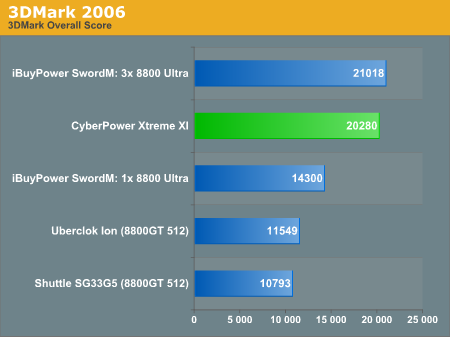
It's impressive that two GTX 280s are providing nearly enough power to match triple 8800 Ultras, but at the same time we're comparing the latest and greatest from NVIDIA to last generation hardware. Considering you can now purchase three 9800 GTX+ cards for $600 vs. $840 for two GTX 280 cards, and you might be tempted to stick with last-gen hardware. Of course, 3-way SLI isn't always as seamless as 2-way SLI.
3DMark Vantage
We gave some coverage to 3DMark Vantage when it first debuted. As a brief recap, Vantage runs on Windows Vista only, and has four different default test settings: Entry, Performance, High, and Xtreme. We promised more results in the preview, and today we have just that, comparing the Xtreme XI to our original test system. Vantage will be a new addition to our test suite, and though the new payment scheme is inconvenient, it is still user reproducible (once).
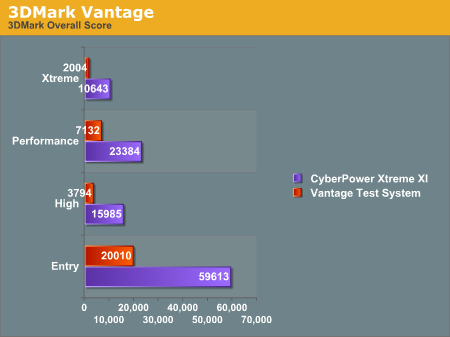
The CyberPower machine well and truly demolishes a respectable gaming machine (Q6600 @ 3.3GHz, SLI 3870s). We have a new bar to shoot for. Then again, the cost of the "old" Vantage test system comes out to a paltry $1200 or so. The disparity between the CPU and GPU score is quite a bit less on the CyberPower machine at Xtreme settings (1920x1200), a testament to the power of the GTX 280s.
Crysis
Crysis is punishing to even the most recent PC hardware. This demo also has two built-in benchmarks in the "bin32" folder, one "CPU" and the other "GPU". We ran several configurations to show the scalability of this game. We ran all benchmarks three times, discarding the first result and averaging the other two. We ran all tests at "High" quality unless otherwise specified. Per Derek's recent findings, Crysis benchmarks were run with VSync at default settings (i.e. not forced off in the driver).
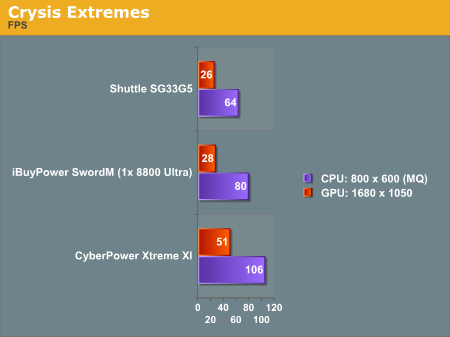
Looking at opposite ends of the spectrum here, we see that the CPU benchmark runs very quickly, but remember that Crysis has a seemingly endless thirst for GPU power and is completely GPU bound at higher resolutions.
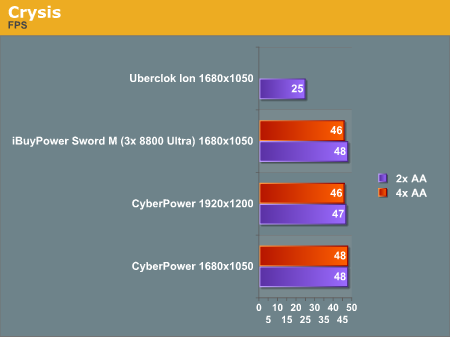
We see further evidence of the brick wall here; at the higher resolutions, frame rates consistently stick around the 45-50 mark at High quality. Raising the quality level to Very High at 4xAA yielded a 15 FPS result, so that's not really an option. Also, we noticed none of the "hitching" or jumpiness with this system that we did with our previous SLI system. As some of the comments from the last system article noted, it may be that the 790i platform resolves these issues.
World in Conflict
World in Conflict is a strategy war-game where the Cold War has erupted into a full-scale conflict between the U.S. and the Soviet Union. The demo has a built-in benchmark under Options->Graphics. Quality settings in the game also modify anti-aliasing and anisotropic filtering; however, these were controlled independently while all other settings were left at the default for that quality.
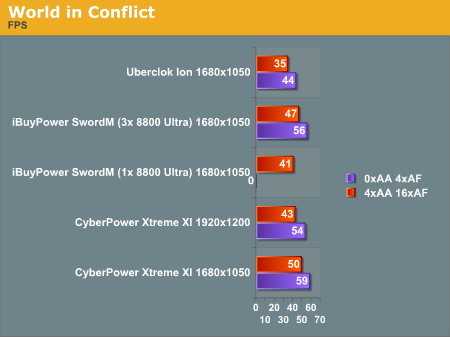
We have very good results here with the CyberPower system. Also worth noting is that at 1680x1050 0xAA 4xAF, the frame rate never drops below 30 FPS, making game play enjoyable even during periods of large explosions (and even at 1920x1200, it only drops to 27). It's very impressive to see the SLI GTX system beat out the Tri-SLI 8800 Ultras here.
Metal Knight Zero Pre-Alpha Benchmark
NVIDIA recently released their "Force Within" Power Pack that included new Detonator drivers with PhysX acceleration for 8xxx, 9xxx, and GT200-class video cards. It also offers some demos, UT3 maps, a full game (Warmonger), and a trial version of Badaboom, among other things. We downloaded MKZ and gave the "High" (1920x1200) benchmark a whirl.

The game runs through a pre-recorded timedemo that is clearly aimed at showing off the PhysX capabilities. Banners blowing in the breeze while getting shot up with holes and ripping down, and vehicles exploding into little tiny bits is the norm.










30 Comments
View All Comments
initialised - Saturday, August 30, 2008 - link
To get the most out of the Asetek LCLC we usually fit fans in push-pull. This took a Q9550 at 3.6GHz from 70-75 loaded to 55-60 Loaded. I'm surprised our American cousins hadn't thought to do this. I have a similar system to this under testing right now at 4.2GHz temps not really braking 65, Cosmos-S case though. Having said that, a system with a 4870x2 and 3.8GHz quad is not far behind it in terms of performance. For us Safe & Stable typically means knock the CPU FSB up a notch and XXX means go further on the CPU and OC the RAM and graphics where possible.bob4432 - Sunday, August 24, 2008 - link
w/ your comment - "CyberPower's website comes up immediately from a web search"what did you type into the search engine? and which engine?
2x 1KW....ridiculous as the norm lately....
JarredWalton - Sunday, August 24, 2008 - link
"CyberPower"... Google gives it the number one spot as do MSN and Yahoo. If you put a space in the name, the results aren't changed. Not sure what you would search for that wouldn't have a quick hit.bob4432 - Sunday, August 24, 2008 - link
it is pretty easy to get #1 when you know the name....you need to search w/ stuff other than a direct name, especially the domain name or nearly the domain name, that is a near 100% chance of it being #1. say you don't know the name and you just type in "buy custom online pc" - you get different results.because of this i really wouldn't give them any kudos on their website because a search engine gave them #1 when you typed in almost their domain directly and company name.
getting to #1 for them w/ the way you searched is extremely easy....
Matt Campbell - Sunday, August 24, 2008 - link
Perhaps it is easy, but more than one OEM we've evaluated has *not* come up with a direct web search of their name, which (as you can imagine) makes them quite difficult to locate if you don't know anything else about them.oralpain - Saturday, August 23, 2008 - link
I notice that, in this review, you have CoreTemp calibrated to a TJmax of 105C.According to Intel, the actual TJmax rating of the QX9770 is 85C. Since CoreTemp, and other programs like it, are only capable of measuring the delta to TJmax, proper calibration is critical to knowing actual (load) temperatures.
In your load tests, the CPU only reached into the 70sC, not the 90s.
Source for the TJmax ratings: http://intel.wingateweb.com/US08/published/session...">http://intel.wingateweb.com/US08/publis...sessions...
Matt Campbell - Saturday, August 23, 2008 - link
Thanks for noting this. I did see Kris' update on Thursday as well, here: http://www.anandtech.com/weblog/showpost.aspx?i=47...">http://www.anandtech.com/weblog/showpost.aspx?i=47..., which finally gives us solidified TJmax numbers to work with. As this was just made public information on the 21st, however, the article had already been sent in for publication. I will re-run the test and post the results.brian_riendeau - Friday, August 22, 2008 - link
"The cooling is sufficient I think, for everywhere except perhaps the CPU. I'd wager that an Ultra-120 eXtreme would beat it, but that's just a guess. As for the rest of the comments, while two PSUs is certainly overkill for this particular configuration, doubling the RAM will hardly have an impact on most things. I've got a 4GB system and a 2GB system (64-bit and 32-bit), with similar parts elsewhere. Unless I really open a LOT of applications (and 32-bit ones at that, since there are very few 64-bit apps), I couldn't tell them apart."and from the review...
"they took an extra step in integrating them into a solution with reasonable component choices that worked well together and provided a stable operating platform"
Fact is with Vista SuperFetch preloading commonly used files into RAM during idle times, the performance benefits of extra RAM really start to pay off even as you go over 4GB. With 8GB of RAM, it will cache up most of the games you typically play bringing launch times and level switch times down dramatically. This is the type of thing that has a huge difference in the real world feel, but rarely shows in benchmarking. Given the minimal cost of another 4GB of RAM and the system going over $5.5K in cost, I think its ridiculous for this system not to come with 8GB of RAM from the start.
JarredWalton - Friday, August 22, 2008 - link
The problem is that most games are now well over 4GB, and the data they use is so variable (one level uses a certain 1GB, the next level uses a different 1GB, etc.) If you surf the web a lot, run your email app, Word, Excel, and play several different games, SuperFetch gets overwhelmed.But you know what? All that is beside the point! You want 4x2GB RAM? It's an option. You want a case with one PSU? They've got that too. That's why this is a review of both a specific PC (the Gamer Extreme XI) plus plenty of commentary on CyberPower as a whole. You want a different config? How about this, which is probably what I would go with for high-end right now:
Gamer Infinity 8900 Deluxe
--------------------------
CoolerMaster Centurion 590 RC-590 Mid-Tower Case
3 extra case fans
Thermaltake ToughPower 1,000W PSU
Core 2 Quad Q9550
Thermaltake Big Typhoon VX
GigaByte GA-EP45T-DS3R
4x2GB DDR3-1333 ("Major brand")
ATI Radeon HD 4870X2 (Feel free to add a second)
300GB Western Digital Raptor
1TB 32MB 7200RPM HDD
LG GGC-H20L BLU-RAY/HD-DVD Reader/DVD±R/±RW Writer
(Onboard audio and network)
Logitech Wave Keyboard
Razer Diamondback 3G Blue Mouse
12-in-1 Flash reader
Vista Ultimate 64-bit
3-year warranty
Total CyberPower cost: $3057 + shipping and tax
CoolerMaster Centurion 590 RC-590 $65
3 x 120mm case fans $12
Thermaltake ToughPower 1,000W PSU $310
Core 2 Quad Q9550 $330
Thermaltake Big Typhoon VX $53
GigaByte GA-EP45T-DS3R $160
4x2GB Patriot DDR3-1333 $358
PowerColor Radeon HD 4870X2 $560
300GB Western Digital Raptor $295
SAMSUNG Spinpoint F1 HD103UJ 1TB 7200 RPM 32MB $150
LG GGC-H20L $150
Logitech Wave Keyboard $50
Razer Diamondback 3G Blue Mouse $50
12-in-1 Flash reader $20
Vista Ultimate 64-bit (OEM) $180
Warranty ???
Total for parts purchased at Newegg: $2,743
(Tax and shipping also missing.)
$300 for an extra 2-year warranty, plus assembly and testing, and shipping is likely to be less than the individual parts. Again, the comparison is quite favorable.
HanSolo71 - Friday, August 22, 2008 - link
in your previous rig you said you had a Q6600 @ 3.3 Ghz and SLI 3870's how can you have SLI ATI cards?